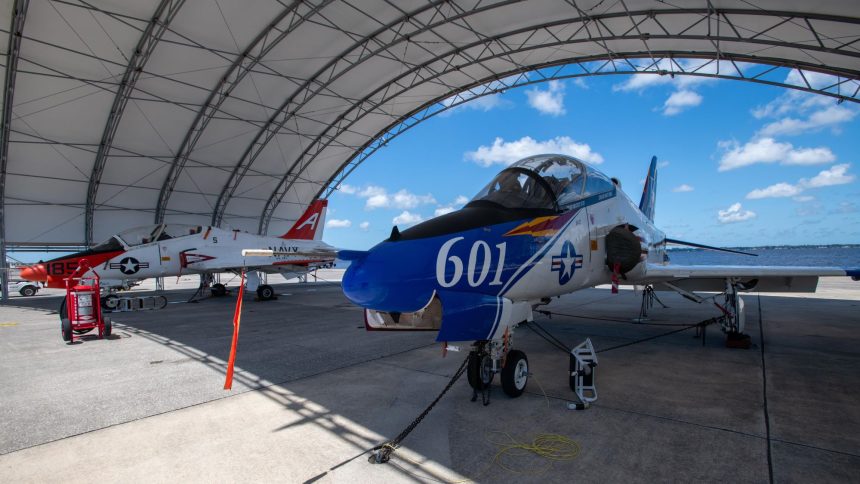The Fleet Readiness Center Southeast inducted its first two T-45 Goshawks into the Service Life Extension Program production line, 13 months after the Navy identified the requirement.
The U.S. Navy has started working on the Service Life Extension Program (SLEP) of the T-45 Goshawk, with the first two aircraft recently inducted at the Fleet Readiness Center Southeast (FRCSE), announced the Naval Air Systems Command (NAVAIR) on Jul. 22, 2025. The induction of the two aircraft comes 13 months after the Navy identified the requirement, explained the service.
The Goshawk is the primary tandem-seat jet trainer for the Navy and Marine Corps, used by student aviators to earn their pilot carrier qualification. The certification is mandatory for pilots before flying any other carrier-capable aircraft like the F/A-18, F-35B or F-35C used by the Navy and the Marine Corps.
The T-45 is managed by the Program Executive Office for Tactical Aircraft Programs (PMA-273), which would work with Vertex Aerospace (V2X) for the SLEP. V2X currently manages all T-45 organizational-level, intermediate-level and depot-level maintenance, NAVAIR said.
In fact, NAVAIR awarded V2X the T-45 Aircraft Maintenance and Contractor Logistics Support in Nov. 2021. FRCSE also received “organizational-level training” from V2X “to support the SLEP and help achieve the Navy’s readiness and pilot training objectives.”
The press release explains FRCSE worked together with V2X, PMA-273 and CNATRA for the personnel training required for the arrival of the first two aircraft that will undergo the SLEP.
They’re changing the T-45 Goshawk from its iconic orange and white paint scheme to a dark grey. pic.twitter.com/dYFhu4k69x
— Eric Daniel Kotyk (@SSgtKotyk) October 17, 2024
T-45 SLEP begins
As we can see in the image released by NAVAIR, neither of the T-45s sport the “glossy grey” paint scheme that the Chief of Naval Aviation Training (CNATRA) announced that will be applied to the aircraft in 2024. The reason for the new paint scheme was to align them with other operational aircraft and foster a deeper endearment between the Student Naval Aviators (SNA) and the fleet.
While one T-45C with the red-and-white livery (modex 185) is assigned to the VT-7 “Eagles” (Training Squadron SEVEN) within the TW-1 (Training Air Wing-1), the other with the blue-and-white paint scheme (modex 601) belongs to TW-6’s VT-86 “Sabrehawks.”
NAVAIR said that while one T-45 will undergo only a wing swap, the other will receive the “full scope of SLEP work.” A wing swap work allows “aircraft to fly into FRCSE and exchange their wings with ones that have already undergone repair, enabling more efficient turnaround times.”
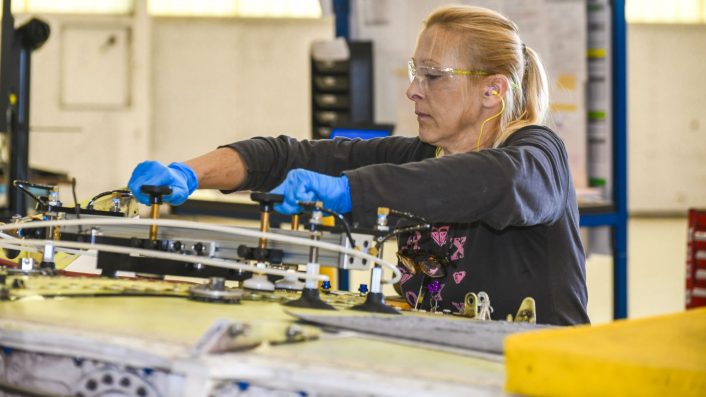
“The capability required FRCSE to develop an incremental approach to perform SLEP on the wings before aircraft fuselage induction for full SLEP production line establishment,” added the NAVAIR statement. The detached wings are repaired and then installed on the next incoming aircraft in a cyclical process.
The release quoted FRCSE Business Development Office aircraft, structural and mechanical component lead James Bock, who said the T-45’s 29 distinct configurations made the partnership with V2X particularly critical. A full SLEP requires accurately complying with 17 technical directives, underscoring the complexity and importance of the collaboration.
The USN initially operated the T-45A, later transitioning to the T-45C variant. The T-45A, which became operational in 1991, featured an analog cockpit, while the newer T-45C, first delivered in December 1997, sports a digital glass cockpit.
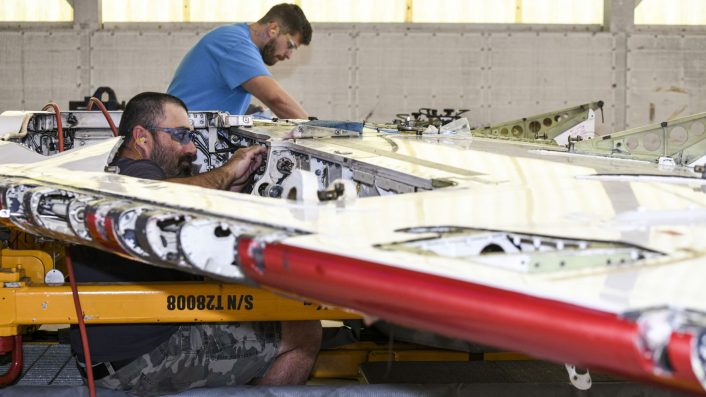
SLEP facility, wing swap equipment and training
The FRCSE announced in May a dedicated SLEP production line facility, prior to the T-45 arrivals, to meet its expected workload of 12 aircraft, estimated to last between 2028 to 2030. At the time, FRCSE was working on one fuselage and three wings, with each wing SLEP expected to take 4,000 working hours and each fuselage to take 24,000.
FRCSE personnel then began practicing on a stricken aircraft for the mock proposed engineering repairs, according to Bock. FRCSE artisans also switched from standard tooling to metric kits, since the T-45 was built using metric measurements.
The team divided the initial depot capability (IDC) into phases. They “trucked in three wings and performed SLEP on all three,” easing their transition to IDC phase two. Thus aircraft can just fly in and “swap their wings with ones that have already undergone SLEP,” Bock explained.
In the final full depot capability stage, aircraft get the “full scope” of SLEP work. The FRCSE also acquired a “flip jig,” which “turns over or flips” the 2,000 pound wing, allowing engineers to work on the wing’s underside – which sees the majority of the work.
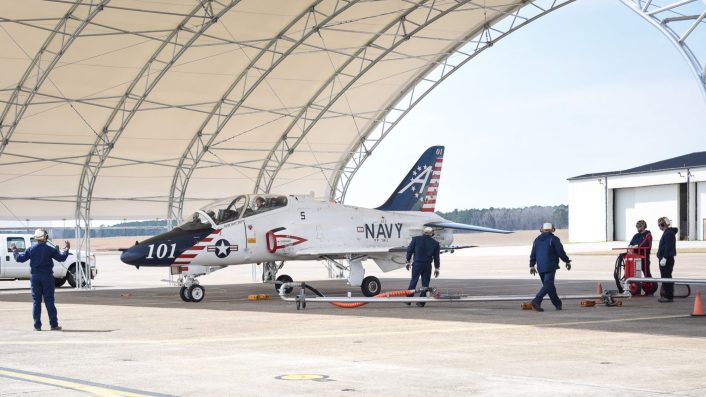
On Jun. 28, 2025, CNATRA and NATRACOM (Naval Air Training Command) announced setting up of the first Aircraft Protective Enclosures (APEs) over refueling sites of Training Wing ONE (TW-1) at Naval Air Station (NAS) Meridian and Training Wing TWO (TW-2) at NAS Kingsville. The APEs cover a ‘hot pit’ refuel, where an aircraft is refueled immediately after landing, while keeping the engine running.
T-45 replacement
A derivative of the BAE Systems Hawk used by Britain and India, the T-45 is likely to remain in service well past the next decade as NAVAIR said it expects to conduct the repairs “through 2036.” The T-45 is a relatively young aircraft at only 36 years old, entering service only in 1988, unlike its 64-year-old Air Force counterpart the T-38 Talon.
The Navy considered three candidates for the T-45 replacement: the Boeing-Saab T-7A Red Hawk (winner of the Air Force’s T-X program), the Lockheed Martin-KAI T-50, and the Leonardo-Textron M-346N. The replacement program, called the Undergraduate Jet Training System (UJTS) has been delayed, and a fourth RFI (Request for Information) was issued on Mar. 31, 2025.
The aircraft would not have to be carrier-capable and would not be required to make touchdowns on FCLP (Field Carrier Landing Practice) sessions. Both require significant modifications to the structure, airframe and landing gears. This marks a notable difference compared to past Navy trainers such as the T-45.
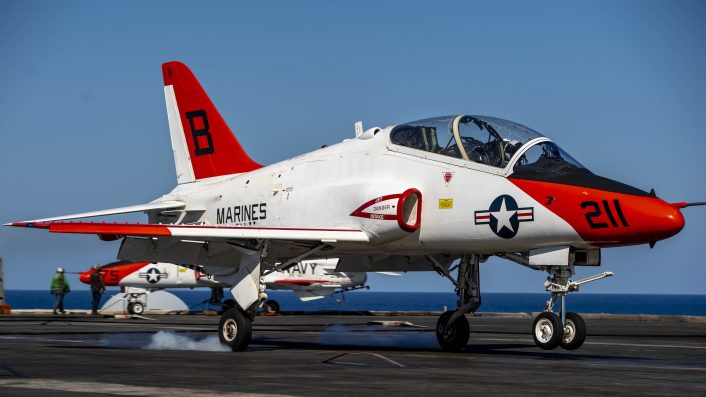
The T-45 however needs an urgent replacement, given recurring problems with the fleet, the latest being a service-wide grounding ordered on Mar. 11, 2025, following an engine malfunction, and issues with oxygen supply. “The point of the service life extension program is to extend the flyable hours on the T-45 aircraft,” Jeff Cavanaugh, FRCSE’s F-5 production line lead, said in the May NAVAIR release.

